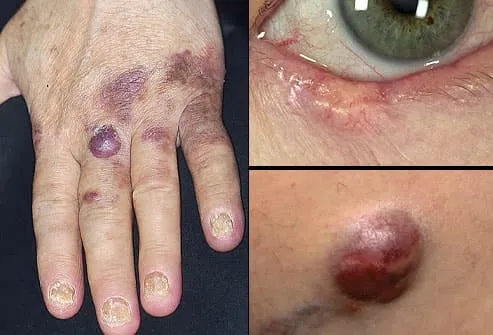Skin Cancer Signs Biography
Source (google.com.pk )Melanoma is a cancer that develops in melanocytes, the pigment cells present in the skin. It can be more serious than the other forms of skin cancer because it may spread to other parts of the body (metastasize) and cause serious illness and death. About 50,000 new cases of melanoma are diagnosed in the United States every year.
Because most melanomas occur on the skin where they can be seen, patients themselves are often the first to detect many melanomas. Early detection and diagnosis are crucial. Caught early, most melanomas can be cured with relatively minor surgery.
This article is written from the standpoint of the patient. In other words, instead of describing the disease in exhaustive detail, I will try to help answer the questions: "How do I know if I have melanoma?" and "Should I should be checked for it?"
Spots on the skin
Guideline # 1: Nobody can diagnose him- or herself. If you see a spot that looks as though it is new or changing, show it to a doctor. When it comes to spots on the skin, it is always better to be safe than sorry.
Everybody gets spots on their skin. The older we are, the more spots we have. Some of these are freckles, others are moles, and still others are made up of collections of tissue, such as blood vessels or pigment cells. Most of these spots are benign. That means they are neither cancerous nor on the way to becoming cancerous.
Moles
Guideline # 2: The vast majority of moles stay as moles and do not turn into anything else.
Some people are born with moles (the medical name is "nevus" plural "nevi"). Almost everyone develops them, starting in childhood. On the average, people have about 25 moles, though some have fewer and others many more. Moles may be flat or raised, and they may range in color from tan to light brown to black.
When changes such as pain, swelling, or even bleeding come on rapidly, within a day or two, they are likely to be caused by minor trauma, often a kind you don't remember (like scratching the spot in your sleep). If a spot changes rapidly and then goes back to the way it was within a couple of weeks, or falls off altogether, it is not likely to represent anything serious. Keep in mind that what may seem like the sudden appearance of a spot or a rapid change in its appearance may just mean that something (or someone) has prompted you to look at an old spot for the first time.
Nevertheless, this would be a good time to say once again: Nobody can diagnose him- or herself. If you see a spot that looks as though it is new or changing, show it to a doctor. When it comes to spots on the skin, it is always better to be safe than sorry.
The best way to know your risk level is to have a dermatologist perform a full body examination. That way you will find out whether the spots you have are moles and, if so, whether they are "funny looking" in the medical sense.
The medical term for such moles is "atypical." This is a somewhat confusing term, because among other things the criteria for defining it are not clear, and it's not certain that an atypical mole is necessarily precancerous. If you have such moles, your doctor may do a biopsy in order to counsel you about the need for surveillance or further testing.
Sometimes, you learn at a routine skin evaluation that you do not necessarily need annual routine checkups. In other situations, your doctor may recommend regular checks at six-month or yearly intervals.
What are the types of melanoma?
The main types of melanoma are:
Superficial spreading melanoma: This type accounts for about 70% of all cases of melanoma. The most common locations are the legs of women and the backs of men, and they occur most commonly between the ages of 30 and 50. (Note: Melanomas can occur in other locations and at other ages as well.) These melanomas are often barely raised and have a variety of colors. Such melanomas evolve over one to five years and can be readily caught at an early stage if they are detected and removed.
Nodular melanoma: About 20% of melanomas begin as deeper, blue-black to purplish lumps. They may evolve faster and may also be more likely to spread.
Lentigo maligna: Unlike other forms of melanoma, lentigo maligna tends to occur on places like the face, which are exposed to the sun constantly rather than intermittently. Lentigo maligna looks like a large, irregularly shaped or colored freckle and develops slowly. It may take many years to evolve into a more dangerous melanoma.
There are also other rarer forms of melanoma that may occur, for example, under the nails, on the palms and soles, in the eye, or sometimes even inside the body.
Skin Cancer Signs Skin Cancer Pictures Moles Symptoms Sings On Face Spots On Nose Photos Types Pics Wallpapers Pics

Skin Cancer Signs Skin Cancer Pictures Moles Symptoms Sings On Face Spots On Nose Photos Types Pics Wallpapers Pics

Skin Cancer Signs Skin Cancer Pictures Moles Symptoms Sings On Face Spots On Nose Photos Types Pics Wallpapers Pics

Skin Cancer Signs Skin Cancer Pictures Moles Symptoms Sings On Face Spots On Nose Photos Types Pics Wallpapers Pics

Skin Cancer Signs Skin Cancer Pictures Moles Symptoms Sings On Face Spots On Nose Photos Types Pics Wallpapers Pics

Skin Cancer Signs Skin Cancer Pictures Moles Symptoms Sings On Face Spots On Nose Photos Types Pics Wallpapers Pics

Skin Cancer Signs Skin Cancer Pictures Moles Symptoms Sings On Face Spots On Nose Photos Types Pics Wallpapers Pics

Skin Cancer Signs Skin Cancer Pictures Moles Symptoms Sings On Face Spots On Nose Photos Types Pics Wallpapers Pics

Skin Cancer Signs Skin Cancer Pictures Moles Symptoms Sings On Face Spots On Nose Photos Types Pics Wallpapers Pics

Skin Cancer Signs Skin Cancer Pictures Moles Symptoms Sings On Face Spots On Nose Photos Types Pics Wallpapers Pics

No comments:
Post a Comment